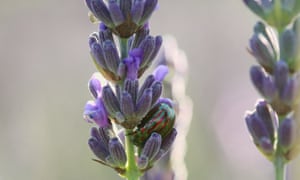
A lover of aromatic plants, the Rosemary beetle (Chrysolina Americana) enjoys a varied diet, including lavender. Photograph: Hoberman Collection/UIG via Getty Images Paul Brown If you discover your favourite aromatic plants and herbs are looking chewed this autumn the culprit is almost certainly the rosemary beetle (Chrysolina Americana), an unwelcome new addition to the UK’s gardens – thanks to climate change.
Despite its name, Americana, its original home is the Mediterranean and North Africa, but the increasing warmth of the British climate means it can now survive and thrive here. It was first seen London in 1994 and after a slow start it has rapidly spread in England and now reached Scotland and Northern Ireland.
While, as the name suggests, it is often found on rosemary, it also eats lavender, sage, thyme and other related aromatic herbs. These are plants which are normally pest free so this makes the beetle a doubly annoying invader.
Both the rather startling metallic green and purple striped adult beetles and the more inconspicuous slug-like greyish white larvae feed on the same plants, chewing their leaves to stumps. The adults, about 6-8mm long, can be found at any time of year, but larvae that grow to the same size, are particularly active during warm autumn weather. A large infestation can reduce most of the plants in the herb garden to skeletons by spring.
This has alarmed, among others, the Royal Horticultural Society (RHS), which has a helpful guide to this invader and how to control it. It also has a campaign to try and track where the beetle has now reached.
The most recent map shows that it is now all over the south-east of England but elsewhere seems to do best in cities, like Manchester, where it is warmer. Large areas of countryside with frosty winters are so far still free of this pest.
One of the problems with control is that many people grow the species that the beetle eats (apart from lavender) to flavour their cooking. Most pesticides which kill the beetles and their lava, also render the herbs uneatable, although the RHS suggest some brands that the makers say are not harmful to humans. However, pesticides will also kill a lot of beneficial insects including bees.
Picking the adult beetles off is laborious so the RHS recommends giving the plants a good shake. On the advice site is a helpful video demonstrating how to place a big piece of white paper under a rosemary bush to catch them all. Someone else suggested an upturned umbrella. How this works for low growing thyme is not shown. In any event once captured they have to be squashed.
The larvae remain active all through the winter or until they are fully-grown. By April all will have dug their way into the soil to pupate, emerging in early summer. Because the beetles live a long time they can be found on the plants all the year round.
The adults do not appear to eat much in summer but in August they start munching, mate and lay eggs.
The good news is that, come the spring, when the larvae disappear into the ground, most chewed plants recover, throwing out new growth to replace their lost leaves. However, the beetles have no natural predators in this country and will soon re-emerge, so control will be needed. Since the beetles are slow, and just hang about on their food plants, the summer is the best chance to fight back.

